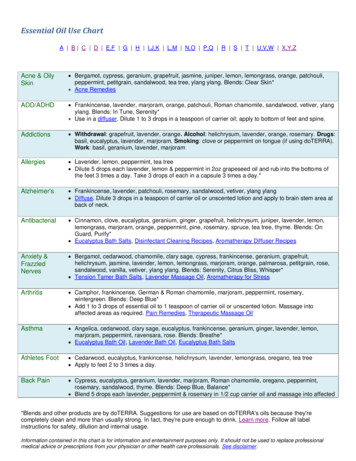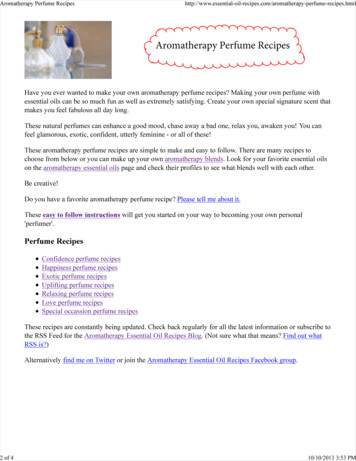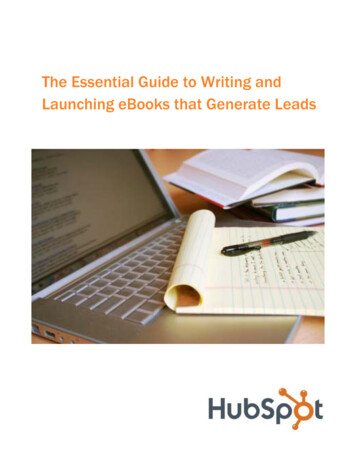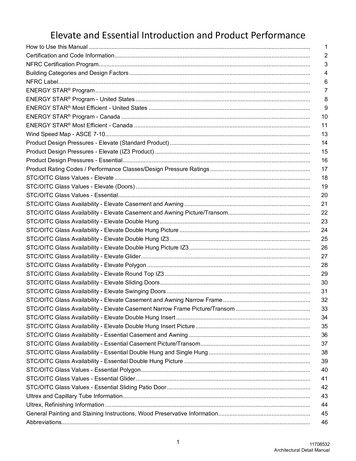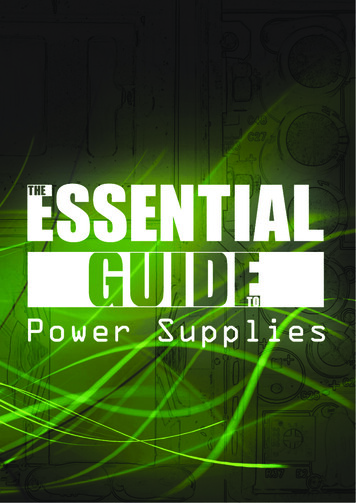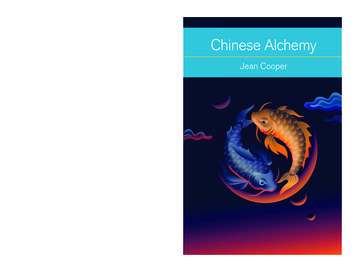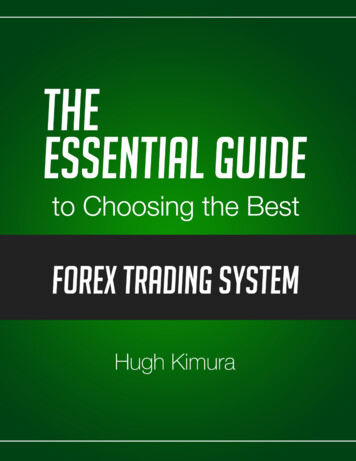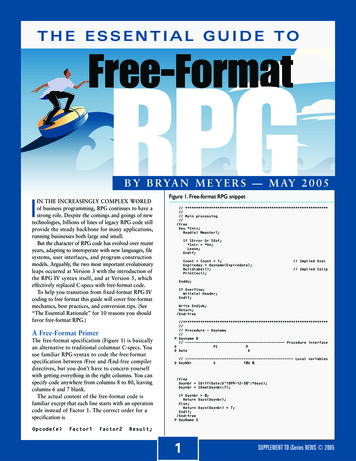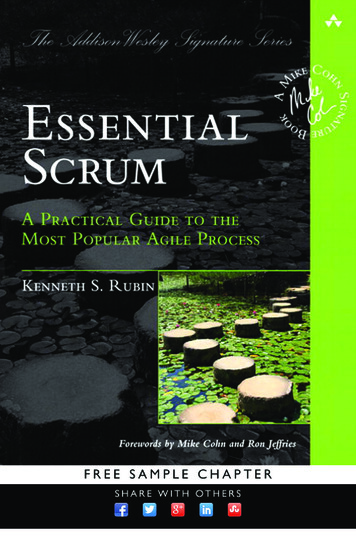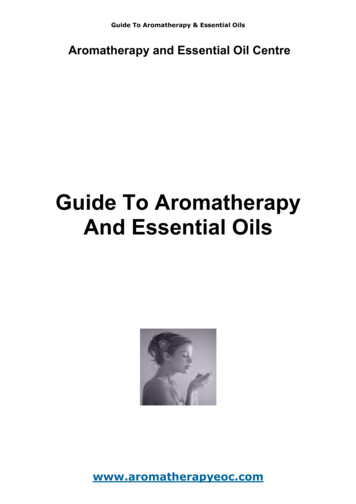
Transcription
Guide To Aromatherapy & Essential OilsAromatherapy and Essential Oil CentreGuide To AromatherapyAnd Essential Oilswww.aromatherapyeoc.com
Guide To Aromatherapy & Essential OilsThe Aromatherapy and Essential Oil Centre is pleased to bring to you acollection of information relating to Aromatherapy and the use ofessential oils in every day life. We provide the widest array ofAromatherapy products on the market. We pride ourselves onproviding the highest quality of Essential Oils and Botanical Extractsavailable as well as pre-blended oils, toiletries and lifestyle productsthat will help you bring Aromatherapy into your life. We hope that youenjoy our publication and that it can impart some additional knowledgeand appreciation for the craft of Aromatherapy.If you don’t see what you’re looking for, or have questions, pleaseemail us and we’ll be glad to assist you.Jeffrey & Victoria SlaterAromatherapy and Essential Oil CentreMelbourne, eoc.com
Guide To Aromatherapy & Essential OilsContentsWhat is Aromatherapy?History of AromatherapyHow are Essential Oils Produced?More About Aromatherapy ProductsWhat are Essential Oils?What are Absolutes?What are CO2s?What are Resins?Favourite Essential OilsEssential Oil Safety InformationUsing Your Essential OilsAromatherapy Tips for BeginnersThe Art of Perfume BlendingRecipesAromatherapy BathsAromatherapy MassageAromatherapy for StressMeasurements for AromatherapyWhat is Aromatherapy?www.aromatherapyeoc.com
Guide To Aromatherapy & Essential OilsBefore progressing into Aromatherapy blends and practical usage fAromatherapy.Aromatherapy by definition “is the practice of using plant oils,including essential oils, for psychological and physical well-being.”Aromatherapy involves the use of essential oils distilled from theleaves, fruit, roots of plants, as well as bark from trees, moss andeven, in some cases, animals, in order to create a therapeutic oremotional sense of well eincomplimentary medicine to the ability to deliver psychologicalbenefits such as relaxation, sensuality, the relief of nervous tensionand stress relief to name a few.Aromatherapy touches all our lives no matter where we live or whatwe do. A few examples of the effects of Aroma upon our daily livescan be seen in just a few examples:A quiet walk down a path on a cool summers night, you pass ajasmine in full bloom, its scent fills the air and your mind.On a shopping trip to the local mall you pass by a bakery selling hotcinnamon buns still hot from the oven, this drives your senses intooverload!Whenever the aroma brings upon a feeling that’s Aromatherapy atwork.The art of aromatherapy is to harness the power of plantfragrance, by way of one of the over 400 essential oils available, inorder to achieve and emotional or therapeutic benefit.The good news is that with the right essential oils, anyone can usebasic aromatherapy methods without intensive training. It is vitalthat the highest quality essential oils are used.The best news isthat The Aromatherapy and Essential Oil Centre carries one of thelargest selection of essential oils and aromatherapy productsavailable.www.aromatherapyeoc.com
Guide To Aromatherapy & Essential OilsHistory of AromatherapyAromatherapy has been around a verylong time and can be traced back to over4000 years before the birth of Christ.Ancient civilisations used essential oils likecinnamon, ginger, myrrh and sandalwoodfor their medicinal use. Over 4000 yearsago Indian literature listed over 700 plantbased ingredients for their medicinal value.TraditionalIndianmedicineknownasAyurveda incorporates aromatic massageas one of its main aspects. This form ofAromatherapy has changed little to thisday and is becoming very popular in Western Aromatherapy.Chinese civilizations also mastered the use of essential oils andherbs. In the year 2700 B.C., a Chinese practitioner, Shen Nungauthored an herbal book that is the oldest surviving medical book inexistence, containing information on over 400 plants. Around thesame time, on the other side of the world, the Egyptians were alsodeveloping Aromatherapy. They practiced aromatherapy in muchthe same way the Chinese, by herbal extraction and by burningaromatic woods and incense to show respect to their gods.When embalming the Pharaohs, the body was first filled with ablend of palm wine infused with the herbs of Chamomile andGalbanum, which cleansed the body before being filled with massiveamounts of the oils of Cinnamon, Myrrh Cassia and other aromaticessences.Oils were then rubbed over the body before beingwrapped in cloth saturated with the essential oils or Myrrh,Cinnamon, juniper and Cedarwood. This process preserved themummy for its afterlife.Besides the religious use of aromatherapy, wealthy Egyptians usedessential oils in their everyday life. The Egyptians would use oils asperfume, bath oil, skin and hair care. Ancient Papyri found in Thewww.aromatherapyeoc.com
Guide To Aromatherapy & Essential OilsPyramids of Egypt told of the practical use of essential oils in thetreatment of all of illnesses as well as how they actually applied theoil. Interestingly similar to the way it is done today.One of the earliest forms of aromatherapy used by the Egyptianswas incense, created from a dried infusion of oils from aromaticplants pressed into cones. They used the incense as offerings totheir many gods, a practice still used in religion today.Along with the Egyptians, Ancient Greeks also mastered the use ofessential oils, using them medicinally and cosmetically. Over 1,200years ago, Pedacius Dioscorides, a Greek physician, authored abook on herbal medicine. Many of his remedies are still in use todayin Aromatherapy.As the Romans expanded their empire into Greece and Egypt, theylearned much of their medical knowledge from these advancingsocieties, using and improving the science of aromatherapy. As theRoman Empire moved towards the Orient, new oils were introducedinto Europe from India, China and the Arab Empire via the newlyexpanding trade routes.Around 1000 A.D., Avicenna, a physician is believed to have beenthe first person to incorporate the process known as distillation todistil the essence of rose. Also during this period, alcohol was alsofirst distilled by The Arabs, and then combined with essential oils,creating the first perfumes.Spanish Conquistadors invading North and South America broughtnew plants and oils to Europe. The Spanish were amazed at thewealth of medicinal plants found in Incan, Mayan and Aztecbotanical gardens and the knowledge they possessed concerningthe use of plants in medicine. Together with the South AmericanIndians, The Indians of North American also used aromatic oils andproduced their own herbal remedies for both medicinal and religiousceremonies.Interestingly, it was only until the early 19th century that scientistsin Europe began researching the effects of essential oils on humans.www.aromatherapyeoc.com
Guide To Aromatherapy & Essential OilsRene Maurice Gattefosse, a French chemist, began his research intothe healing powers of essential oils after burning his hand in hislaboratory and immersing in it in lavender oil. It was this accidentthat impressed him by how quickly the burn healed when treatedwith an essential oil. In 1937 he published a book about the anti microbial effects of the oils and first used the word, Aromatherapy.He later went on to set up a business producing oils for use infragrances and cosmeticsIn 1964, Dr. Jean Valnet, a French medical doctor, was impressedby Gattefosse's research and began experimenting in his clinic withessential oils as medical therapy. Impressed by Dr. Valnet’s work,Margaret Maury began to apply Valnet’s research into her beautytherapy, customising beauty treatments for her clients individually.She was the first person to set up Aromatherapy clinics inSwitzerland, London and France would use oils to maintain healthy,youthful skin, now known as the day spa.Today Aromatherapy is in greater demand then ever before.Besides the clinical and home use, Spas are opening throughout theworld catering to people of all walks of life. Spas are opening up inurban areas to cater to the stressed out working man and womanproviding them with an hour of pure escapism where they arebathed, massaged, wrapped and treated in recipes that date back tothe ancient Greeks, Romans and Orientals, bringing our story fullcircle.Aromatherapy has also transformed resorts like Bali frombudget destinations into high-class, high priced, Spa retreats for therich providing ancient Indian Aromatherapy remedies to the stressof being wealthy!Today the Internet is helping to spread the ancient secrets to nAromatherapy as well as sites like Aromatherapyeoc.com that offermost of the essential oils available at a low cost. Together, thesesites make it possible for everyone to practice Aromatherapy withthe knowledge of professionals.www.aromatherapyeoc.com
Guide To Aromatherapy & Essential OilsHow are Essential Oils Produced?Most people are surprised to learn that for example that it requires2000kg of rose petals to make 1kg of rose essential oil, 6 tonnes oforange blossom to produce 1kg of neroli, 400kg of thyme toproduce 1kg of pure essential oil, and 4 million jasmine flowers toproduce 1kg of jasmine absolute. For this reason, many Essentialoils are very expensive to produce.This is due to the labourintensive process and the quantity of the plant required to producethe oil.Essential oils are the pure "essence" of a plant. The oils have beenfound to provide both psychological and physical benefits whenused correctly and safely. There are over 400 essential oils currentlyavailable on the market today. Many of these oils are very difficultto find in retail stores. The Aromatherapy and Essential Oil Centrewas created to provide most of the oils available today at in order toassist our clients in finding common, as well as rare oils at costsmuch lower then retail shops.We have highlighted many of theseoils on our website.It is important to note that oils used in perfumery, fragrance oils or"fragrances" are different then essential oils. Most perfumescontain chemically based copies of essential oils.This is done topreserve the scent of the perfume and to increase its shelf life.Most fragrances contain unnatural chemicals and do not provide thetherapeutic benefits of essential oils.www.aromatherapyeoc.com
Guide To Aromatherapy & Essential OilsMore About Aromatherapy ProductsAs we stated before, not all aromatherapy products labelled withthe word "aromatherapy" are pure and natural. Many of theseproducts contain artificial ingredients and do not provide actualaromatherapy benefits. Always check the ingredients if you see“fragrance” or artificial chemicals stay clear. Always look on thebottle for pure essential oils and try to avoid those that have wordslike fragrance. All products sold by The Aromatherapy and EssentialOil Centre is made from the highest quality, pure essential oil andlists all ingredients that comprise our blends.www.aromatherapyeoc.com
Guide To Aromatherapy & Essential OilsWhat are Essential Oils?An Essential Oil is a liquid that is generally distilled using steam orwater from the flowers, bark, leaves, seeds, stems, roots, or otherelements of a plant. Contrary to the use of the word oil, Essentialoils are not an oil in the way most people think. As oils are derivedfrom many different parts of a plant, they are not an oil in the truesense. They come in a variety of colours and consistency, from aclear, watery texture, to a thick, syrupy and dark.Essential Oils contain the true essence of the plant. They are veryconcentrated and therefore should be used sparingly. Oils thereforerepresent outstanding value for money as a little oil goes a longway.Essential oils are not the same as perfume or fragrance oils.Where essential oils are derived from the true plants, perfume oilsare artificially created fragrances and contain artificial substancesfragrant oils are not to be used in Aromatherapy. Additionally, as itis unknown what chemicals are in fragrance oils, they are never tobe consumed. If you see oils at an unnatural price, it is probably afragrance rather then a true essential oil.For detailed profiles on our oils, see our essential oil factsheets area.Essential oils can very greatly in quality and price. Many factorsaffect the quality and price of an oil, such as the rarity of the plant,the country where it is distilled and grown and conditions that theplant was grown as well as quality standards of the distiller, andhow much oil the plant produces.The Aromatherapy and Essential Oil Centre offers a wide array ofpre-blended, Essential oils that can save you money, as you won’thave to purchase each oil individually however, we encourage youto make your own blends from the hundreds of essential oils andabsolutes we sell. Be creative!www.aromatherapyeoc.com
Guide To Aromatherapy & Essential OilsWhat are Absolutes?Absolutes are highly concentrated aromatic liquids extracted tedistillation requires the use of chemical solvents that are laterremoved during the final stages of production, thus culminating in amore concentrated essence.There are reasons for producing absolutes. Many times steamdistillation of a plant by steam does not extract as much natural oilfrom the plant, or in some cases, breaks down the precious naturaloil in delicate flowers. The solvent extraction methods are oftenused in these cases.As a rule, absolutes are more concentrated than a similar essentialoil. Being more concentrated, an absolute goes much further thenthe essential oil counterpart.What are Carrier Oils?Carrier oils are used to dilute essential oils and absolutes beforeapplying
The Art of Perfume Blending Recipes Aromatherapy Baths Aromatherapy Massage Aromatherapy for Stress Measurements for Aromatherapy What is Aromatherapy? www.aromatherapyeoc.com . Guide To Aromatherapy & Essential Oils Before progressing into Aromatherapy blends and practical usage of essential oils it is important to understand the basics of Aromatherapy. Aromatherapy by definition “is
